Spotify's Innovation Strategies: Disruptive and Sustaining Theories
VerifiedAdded on 2023/06/18
|16
|4942
|404
Report
AI Summary
This report examines Spotify's application of disruptive and sustaining innovation theories to achieve and maintain its leading position in the music streaming industry. It begins by defining innovation and outlining disruptive and sustaining innovation theories, including their characteristics, assumptions, benefits, and limitations. The report then details Spotify's business model and historical development, illustrating how the company initially used disruptive innovation to enter the market by offering a new way to consume music, challenging traditional sales models. Subsequently, it discusses how Spotify employed sustaining innovation to improve its services and maintain a competitive edge. The report concludes with recommendations for future development pathways, emphasizing the importance of continuing to leverage both disruptive and sustaining strategies to stay ahead in the evolving digital landscape. The analysis highlights how Spotify transformed music from a public good to a private good by focusing on user choice and convenience, and how it continues to adapt to consumer needs and market demands.
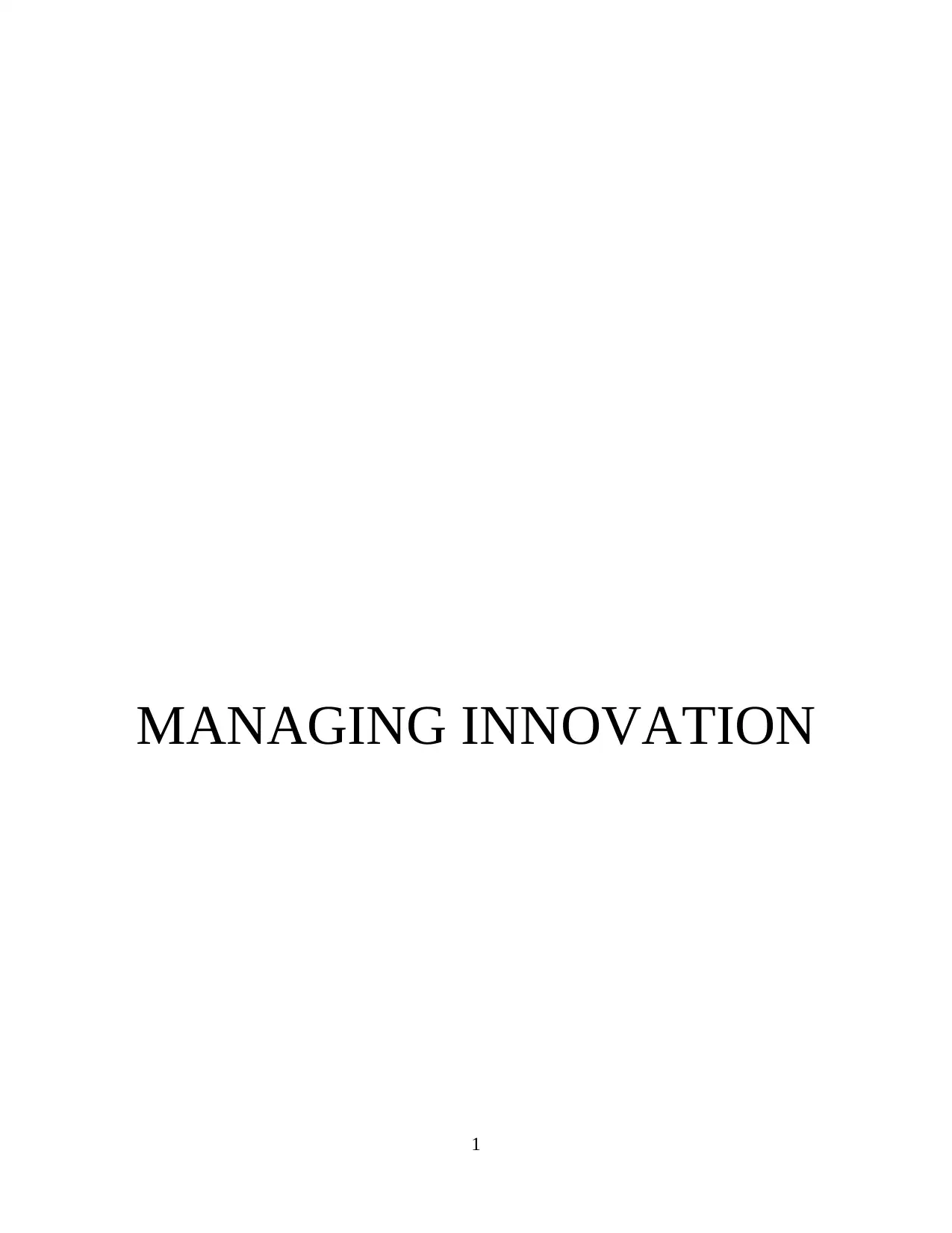
MANAGING INNOVATION
1
1
Paraphrase This Document
Need a fresh take? Get an instant paraphrase of this document with our AI Paraphraser
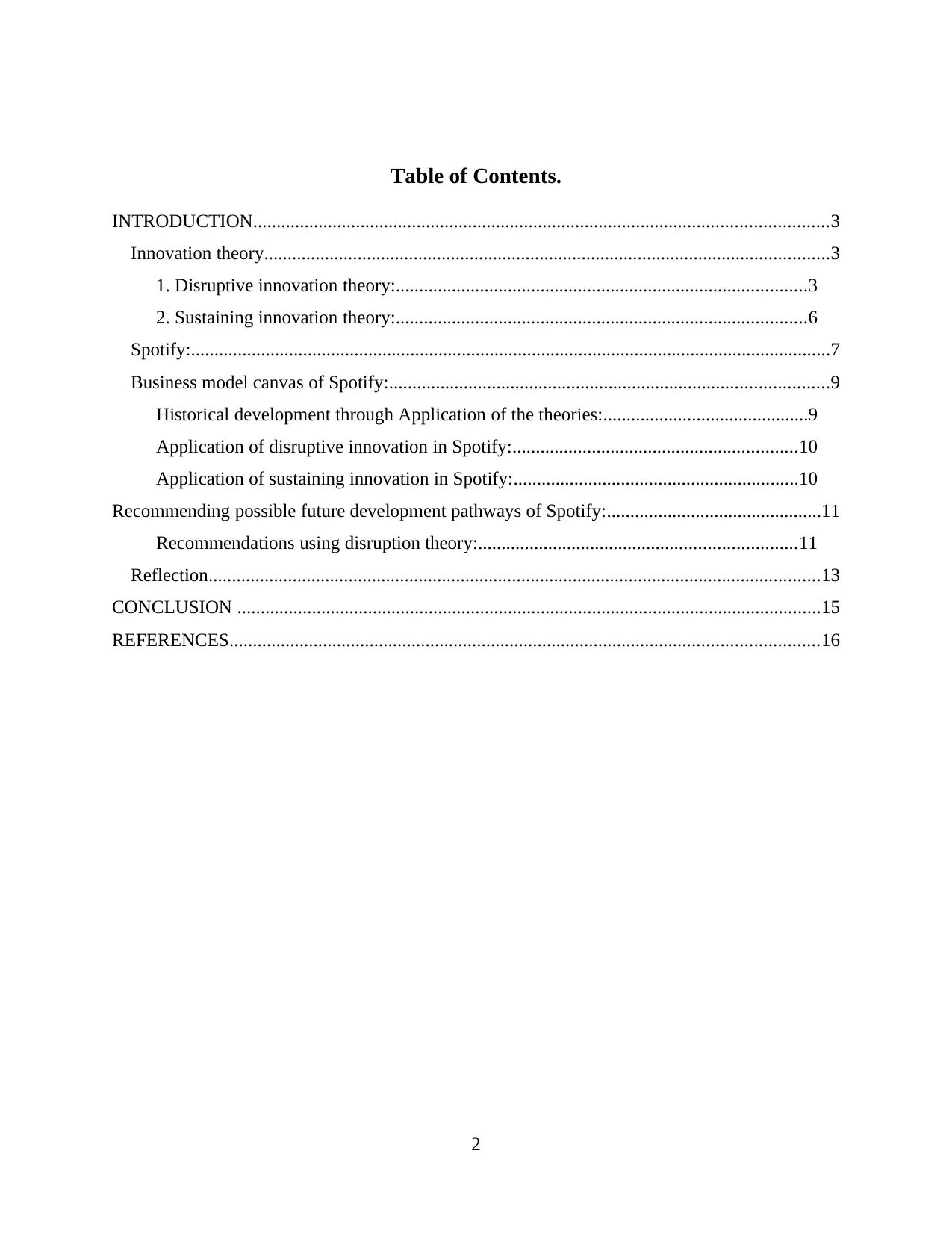
Table of Contents.
INTRODUCTION...........................................................................................................................3
Innovation theory.........................................................................................................................3
1. Disruptive innovation theory:........................................................................................3
2. Sustaining innovation theory:........................................................................................6
Spotify:.........................................................................................................................................7
Business model canvas of Spotify:..............................................................................................9
Historical development through Application of the theories:............................................9
Application of disruptive innovation in Spotify:.............................................................10
Application of sustaining innovation in Spotify:.............................................................10
Recommending possible future development pathways of Spotify:..............................................11
Recommendations using disruption theory:....................................................................11
Reflection...................................................................................................................................13
CONCLUSION .............................................................................................................................15
REFERENCES..............................................................................................................................16
2
INTRODUCTION...........................................................................................................................3
Innovation theory.........................................................................................................................3
1. Disruptive innovation theory:........................................................................................3
2. Sustaining innovation theory:........................................................................................6
Spotify:.........................................................................................................................................7
Business model canvas of Spotify:..............................................................................................9
Historical development through Application of the theories:............................................9
Application of disruptive innovation in Spotify:.............................................................10
Application of sustaining innovation in Spotify:.............................................................10
Recommending possible future development pathways of Spotify:..............................................11
Recommendations using disruption theory:....................................................................11
Reflection...................................................................................................................................13
CONCLUSION .............................................................................................................................15
REFERENCES..............................................................................................................................16
2
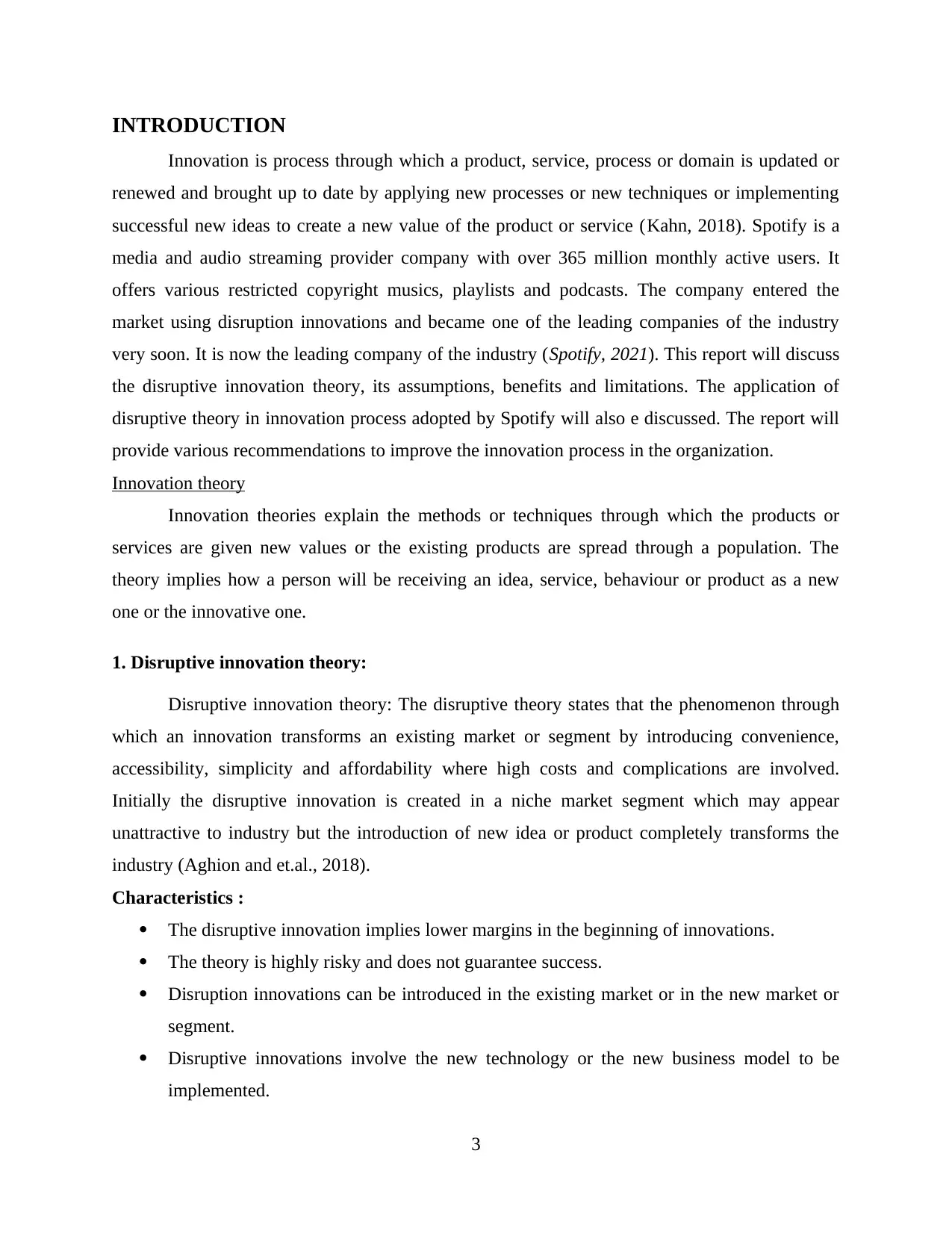
INTRODUCTION
Innovation is process through which a product, service, process or domain is updated or
renewed and brought up to date by applying new processes or new techniques or implementing
successful new ideas to create a new value of the product or service (Kahn, 2018). Spotify is a
media and audio streaming provider company with over 365 million monthly active users. It
offers various restricted copyright musics, playlists and podcasts. The company entered the
market using disruption innovations and became one of the leading companies of the industry
very soon. It is now the leading company of the industry (Spotify, 2021). This report will discuss
the disruptive innovation theory, its assumptions, benefits and limitations. The application of
disruptive theory in innovation process adopted by Spotify will also e discussed. The report will
provide various recommendations to improve the innovation process in the organization.
Innovation theory
Innovation theories explain the methods or techniques through which the products or
services are given new values or the existing products are spread through a population. The
theory implies how a person will be receiving an idea, service, behaviour or product as a new
one or the innovative one.
1. Disruptive innovation theory:
Disruptive innovation theory: The disruptive theory states that the phenomenon through
which an innovation transforms an existing market or segment by introducing convenience,
accessibility, simplicity and affordability where high costs and complications are involved.
Initially the disruptive innovation is created in a niche market segment which may appear
unattractive to industry but the introduction of new idea or product completely transforms the
industry (Aghion and et.al., 2018).
Characteristics :
The disruptive innovation implies lower margins in the beginning of innovations.
The theory is highly risky and does not guarantee success.
Disruption innovations can be introduced in the existing market or in the new market or
segment.
Disruptive innovations involve the new technology or the new business model to be
implemented.
3
Innovation is process through which a product, service, process or domain is updated or
renewed and brought up to date by applying new processes or new techniques or implementing
successful new ideas to create a new value of the product or service (Kahn, 2018). Spotify is a
media and audio streaming provider company with over 365 million monthly active users. It
offers various restricted copyright musics, playlists and podcasts. The company entered the
market using disruption innovations and became one of the leading companies of the industry
very soon. It is now the leading company of the industry (Spotify, 2021). This report will discuss
the disruptive innovation theory, its assumptions, benefits and limitations. The application of
disruptive theory in innovation process adopted by Spotify will also e discussed. The report will
provide various recommendations to improve the innovation process in the organization.
Innovation theory
Innovation theories explain the methods or techniques through which the products or
services are given new values or the existing products are spread through a population. The
theory implies how a person will be receiving an idea, service, behaviour or product as a new
one or the innovative one.
1. Disruptive innovation theory:
Disruptive innovation theory: The disruptive theory states that the phenomenon through
which an innovation transforms an existing market or segment by introducing convenience,
accessibility, simplicity and affordability where high costs and complications are involved.
Initially the disruptive innovation is created in a niche market segment which may appear
unattractive to industry but the introduction of new idea or product completely transforms the
industry (Aghion and et.al., 2018).
Characteristics :
The disruptive innovation implies lower margins in the beginning of innovations.
The theory is highly risky and does not guarantee success.
Disruption innovations can be introduced in the existing market or in the new market or
segment.
Disruptive innovations involve the new technology or the new business model to be
implemented.
3
⊘ This is a preview!⊘
Do you want full access?
Subscribe today to unlock all pages.

Trusted by 1+ million students worldwide
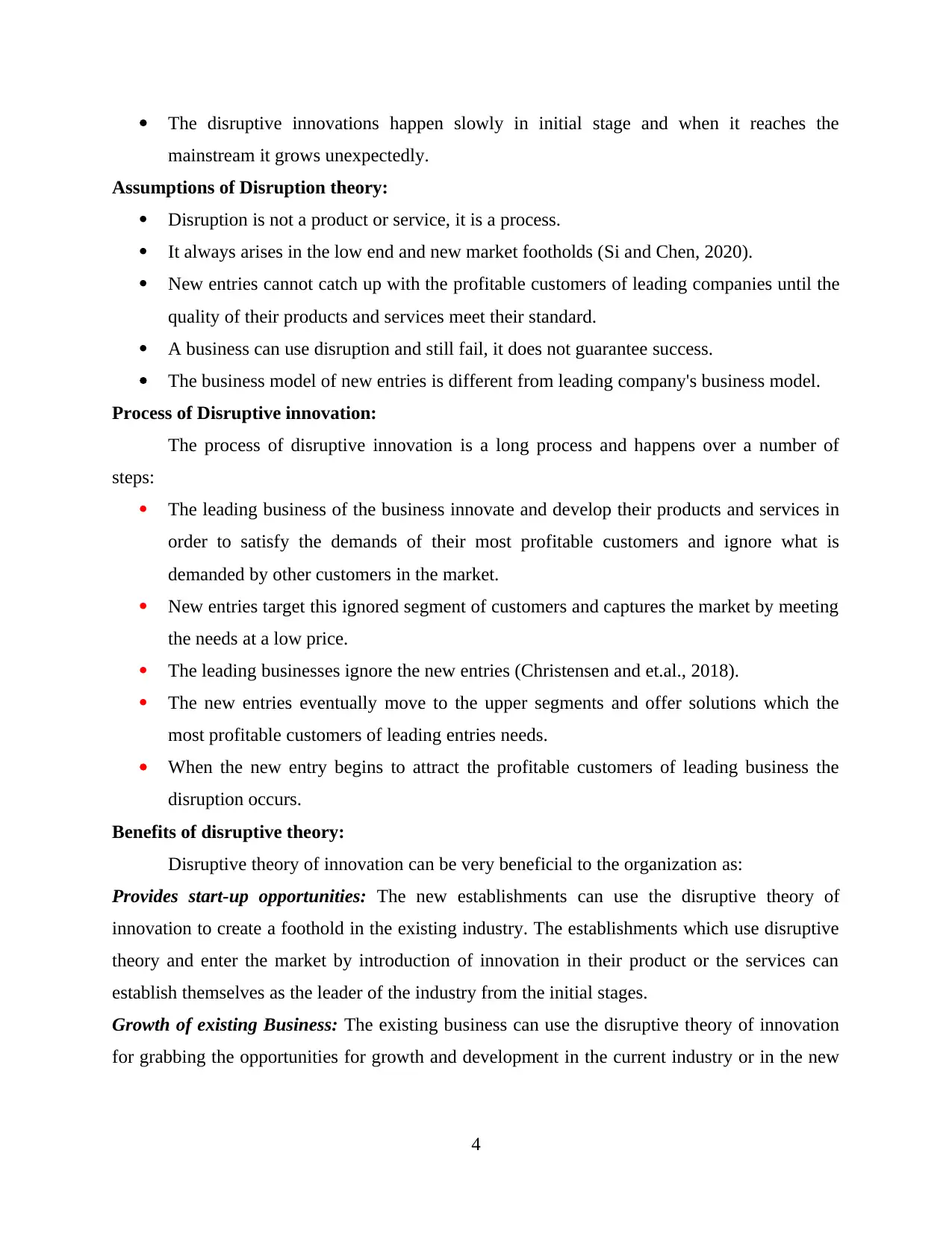
The disruptive innovations happen slowly in initial stage and when it reaches the
mainstream it grows unexpectedly.
Assumptions of Disruption theory:
Disruption is not a product or service, it is a process.
It always arises in the low end and new market footholds (Si and Chen, 2020).
New entries cannot catch up with the profitable customers of leading companies until the
quality of their products and services meet their standard.
A business can use disruption and still fail, it does not guarantee success.
The business model of new entries is different from leading company's business model.
Process of Disruptive innovation:
The process of disruptive innovation is a long process and happens over a number of
steps:
The leading business of the business innovate and develop their products and services in
order to satisfy the demands of their most profitable customers and ignore what is
demanded by other customers in the market.
New entries target this ignored segment of customers and captures the market by meeting
the needs at a low price.
The leading businesses ignore the new entries (Christensen and et.al., 2018).
The new entries eventually move to the upper segments and offer solutions which the
most profitable customers of leading entries needs.
When the new entry begins to attract the profitable customers of leading business the
disruption occurs.
Benefits of disruptive theory:
Disruptive theory of innovation can be very beneficial to the organization as:
Provides start-up opportunities: The new establishments can use the disruptive theory of
innovation to create a foothold in the existing industry. The establishments which use disruptive
theory and enter the market by introduction of innovation in their product or the services can
establish themselves as the leader of the industry from the initial stages.
Growth of existing Business: The existing business can use the disruptive theory of innovation
for grabbing the opportunities for growth and development in the current industry or in the new
4
mainstream it grows unexpectedly.
Assumptions of Disruption theory:
Disruption is not a product or service, it is a process.
It always arises in the low end and new market footholds (Si and Chen, 2020).
New entries cannot catch up with the profitable customers of leading companies until the
quality of their products and services meet their standard.
A business can use disruption and still fail, it does not guarantee success.
The business model of new entries is different from leading company's business model.
Process of Disruptive innovation:
The process of disruptive innovation is a long process and happens over a number of
steps:
The leading business of the business innovate and develop their products and services in
order to satisfy the demands of their most profitable customers and ignore what is
demanded by other customers in the market.
New entries target this ignored segment of customers and captures the market by meeting
the needs at a low price.
The leading businesses ignore the new entries (Christensen and et.al., 2018).
The new entries eventually move to the upper segments and offer solutions which the
most profitable customers of leading entries needs.
When the new entry begins to attract the profitable customers of leading business the
disruption occurs.
Benefits of disruptive theory:
Disruptive theory of innovation can be very beneficial to the organization as:
Provides start-up opportunities: The new establishments can use the disruptive theory of
innovation to create a foothold in the existing industry. The establishments which use disruptive
theory and enter the market by introduction of innovation in their product or the services can
establish themselves as the leader of the industry from the initial stages.
Growth of existing Business: The existing business can use the disruptive theory of innovation
for grabbing the opportunities for growth and development in the current industry or in the new
4
Paraphrase This Document
Need a fresh take? Get an instant paraphrase of this document with our AI Paraphraser
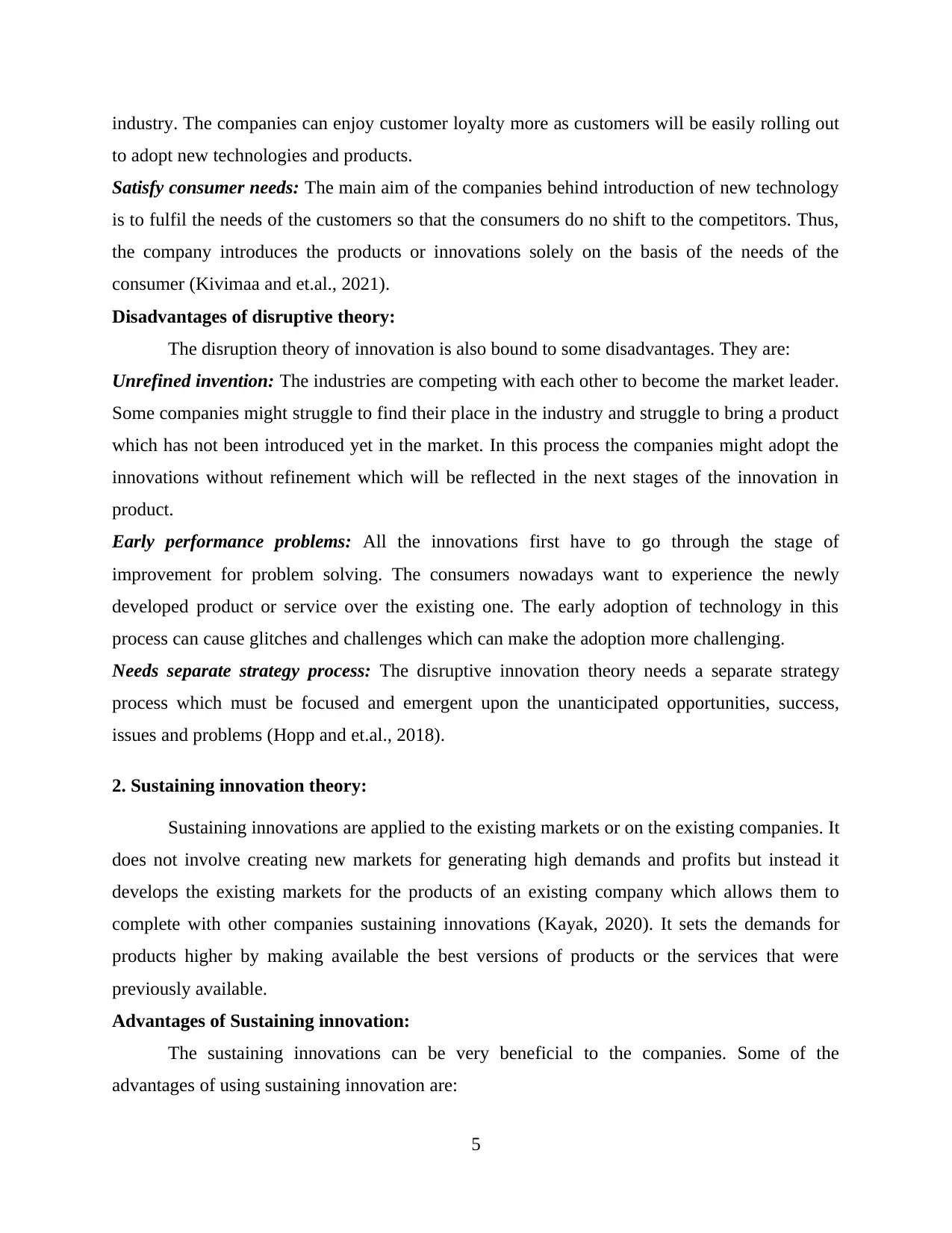
industry. The companies can enjoy customer loyalty more as customers will be easily rolling out
to adopt new technologies and products.
Satisfy consumer needs: The main aim of the companies behind introduction of new technology
is to fulfil the needs of the customers so that the consumers do no shift to the competitors. Thus,
the company introduces the products or innovations solely on the basis of the needs of the
consumer (Kivimaa and et.al., 2021).
Disadvantages of disruptive theory:
The disruption theory of innovation is also bound to some disadvantages. They are:
Unrefined invention: The industries are competing with each other to become the market leader.
Some companies might struggle to find their place in the industry and struggle to bring a product
which has not been introduced yet in the market. In this process the companies might adopt the
innovations without refinement which will be reflected in the next stages of the innovation in
product.
Early performance problems: All the innovations first have to go through the stage of
improvement for problem solving. The consumers nowadays want to experience the newly
developed product or service over the existing one. The early adoption of technology in this
process can cause glitches and challenges which can make the adoption more challenging.
Needs separate strategy process: The disruptive innovation theory needs a separate strategy
process which must be focused and emergent upon the unanticipated opportunities, success,
issues and problems (Hopp and et.al., 2018).
2. Sustaining innovation theory:
Sustaining innovations are applied to the existing markets or on the existing companies. It
does not involve creating new markets for generating high demands and profits but instead it
develops the existing markets for the products of an existing company which allows them to
complete with other companies sustaining innovations (Kayak, 2020). It sets the demands for
products higher by making available the best versions of products or the services that were
previously available.
Advantages of Sustaining innovation:
The sustaining innovations can be very beneficial to the companies. Some of the
advantages of using sustaining innovation are:
5
to adopt new technologies and products.
Satisfy consumer needs: The main aim of the companies behind introduction of new technology
is to fulfil the needs of the customers so that the consumers do no shift to the competitors. Thus,
the company introduces the products or innovations solely on the basis of the needs of the
consumer (Kivimaa and et.al., 2021).
Disadvantages of disruptive theory:
The disruption theory of innovation is also bound to some disadvantages. They are:
Unrefined invention: The industries are competing with each other to become the market leader.
Some companies might struggle to find their place in the industry and struggle to bring a product
which has not been introduced yet in the market. In this process the companies might adopt the
innovations without refinement which will be reflected in the next stages of the innovation in
product.
Early performance problems: All the innovations first have to go through the stage of
improvement for problem solving. The consumers nowadays want to experience the newly
developed product or service over the existing one. The early adoption of technology in this
process can cause glitches and challenges which can make the adoption more challenging.
Needs separate strategy process: The disruptive innovation theory needs a separate strategy
process which must be focused and emergent upon the unanticipated opportunities, success,
issues and problems (Hopp and et.al., 2018).
2. Sustaining innovation theory:
Sustaining innovations are applied to the existing markets or on the existing companies. It
does not involve creating new markets for generating high demands and profits but instead it
develops the existing markets for the products of an existing company which allows them to
complete with other companies sustaining innovations (Kayak, 2020). It sets the demands for
products higher by making available the best versions of products or the services that were
previously available.
Advantages of Sustaining innovation:
The sustaining innovations can be very beneficial to the companies. Some of the
advantages of using sustaining innovation are:
5
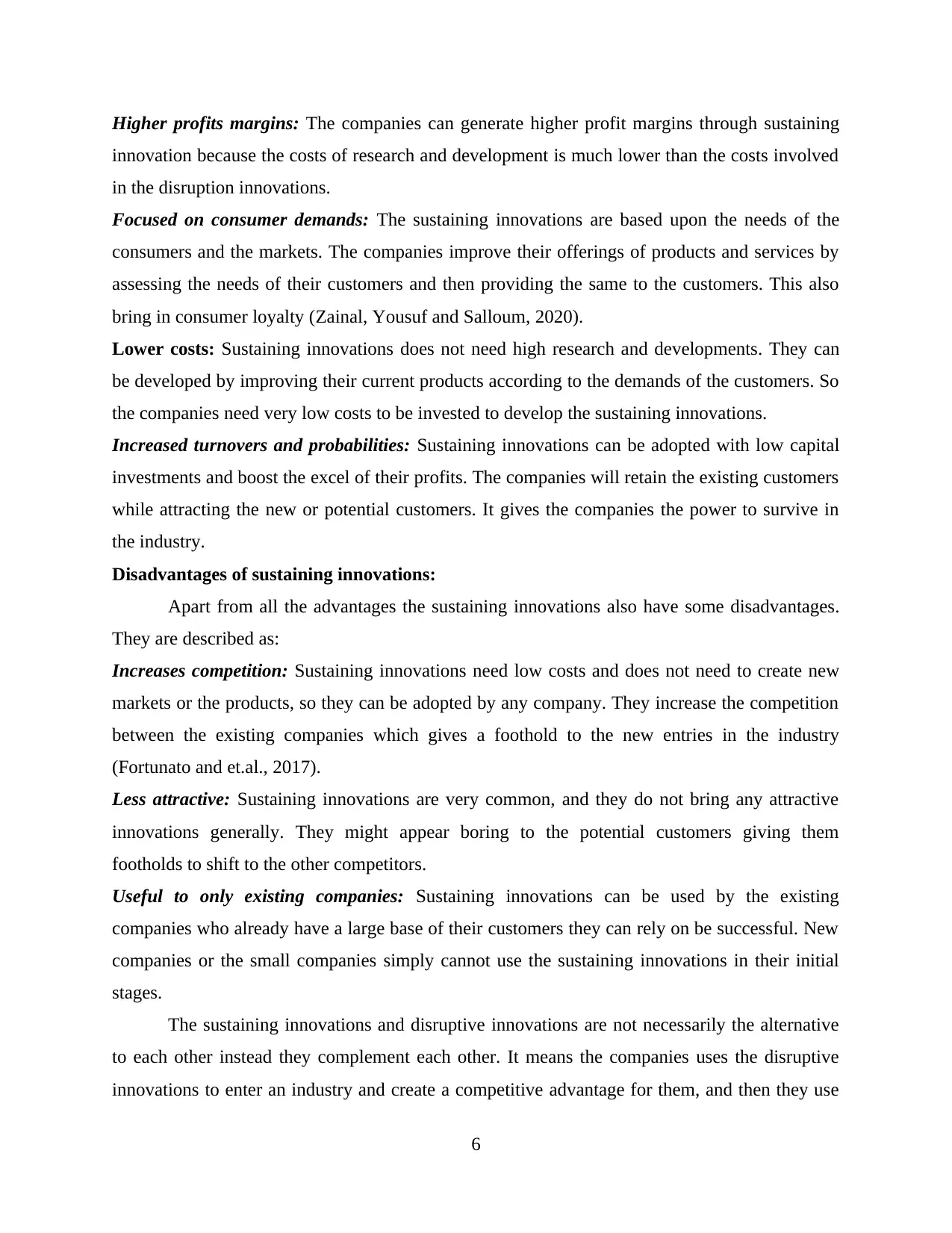
Higher profits margins: The companies can generate higher profit margins through sustaining
innovation because the costs of research and development is much lower than the costs involved
in the disruption innovations.
Focused on consumer demands: The sustaining innovations are based upon the needs of the
consumers and the markets. The companies improve their offerings of products and services by
assessing the needs of their customers and then providing the same to the customers. This also
bring in consumer loyalty (Zainal, Yousuf and Salloum, 2020).
Lower costs: Sustaining innovations does not need high research and developments. They can
be developed by improving their current products according to the demands of the customers. So
the companies need very low costs to be invested to develop the sustaining innovations.
Increased turnovers and probabilities: Sustaining innovations can be adopted with low capital
investments and boost the excel of their profits. The companies will retain the existing customers
while attracting the new or potential customers. It gives the companies the power to survive in
the industry.
Disadvantages of sustaining innovations:
Apart from all the advantages the sustaining innovations also have some disadvantages.
They are described as:
Increases competition: Sustaining innovations need low costs and does not need to create new
markets or the products, so they can be adopted by any company. They increase the competition
between the existing companies which gives a foothold to the new entries in the industry
(Fortunato and et.al., 2017).
Less attractive: Sustaining innovations are very common, and they do not bring any attractive
innovations generally. They might appear boring to the potential customers giving them
footholds to shift to the other competitors.
Useful to only existing companies: Sustaining innovations can be used by the existing
companies who already have a large base of their customers they can rely on be successful. New
companies or the small companies simply cannot use the sustaining innovations in their initial
stages.
The sustaining innovations and disruptive innovations are not necessarily the alternative
to each other instead they complement each other. It means the companies uses the disruptive
innovations to enter an industry and create a competitive advantage for them, and then they use
6
innovation because the costs of research and development is much lower than the costs involved
in the disruption innovations.
Focused on consumer demands: The sustaining innovations are based upon the needs of the
consumers and the markets. The companies improve their offerings of products and services by
assessing the needs of their customers and then providing the same to the customers. This also
bring in consumer loyalty (Zainal, Yousuf and Salloum, 2020).
Lower costs: Sustaining innovations does not need high research and developments. They can
be developed by improving their current products according to the demands of the customers. So
the companies need very low costs to be invested to develop the sustaining innovations.
Increased turnovers and probabilities: Sustaining innovations can be adopted with low capital
investments and boost the excel of their profits. The companies will retain the existing customers
while attracting the new or potential customers. It gives the companies the power to survive in
the industry.
Disadvantages of sustaining innovations:
Apart from all the advantages the sustaining innovations also have some disadvantages.
They are described as:
Increases competition: Sustaining innovations need low costs and does not need to create new
markets or the products, so they can be adopted by any company. They increase the competition
between the existing companies which gives a foothold to the new entries in the industry
(Fortunato and et.al., 2017).
Less attractive: Sustaining innovations are very common, and they do not bring any attractive
innovations generally. They might appear boring to the potential customers giving them
footholds to shift to the other competitors.
Useful to only existing companies: Sustaining innovations can be used by the existing
companies who already have a large base of their customers they can rely on be successful. New
companies or the small companies simply cannot use the sustaining innovations in their initial
stages.
The sustaining innovations and disruptive innovations are not necessarily the alternative
to each other instead they complement each other. It means the companies uses the disruptive
innovations to enter an industry and create a competitive advantage for them, and then they use
6
⊘ This is a preview!⊘
Do you want full access?
Subscribe today to unlock all pages.

Trusted by 1+ million students worldwide
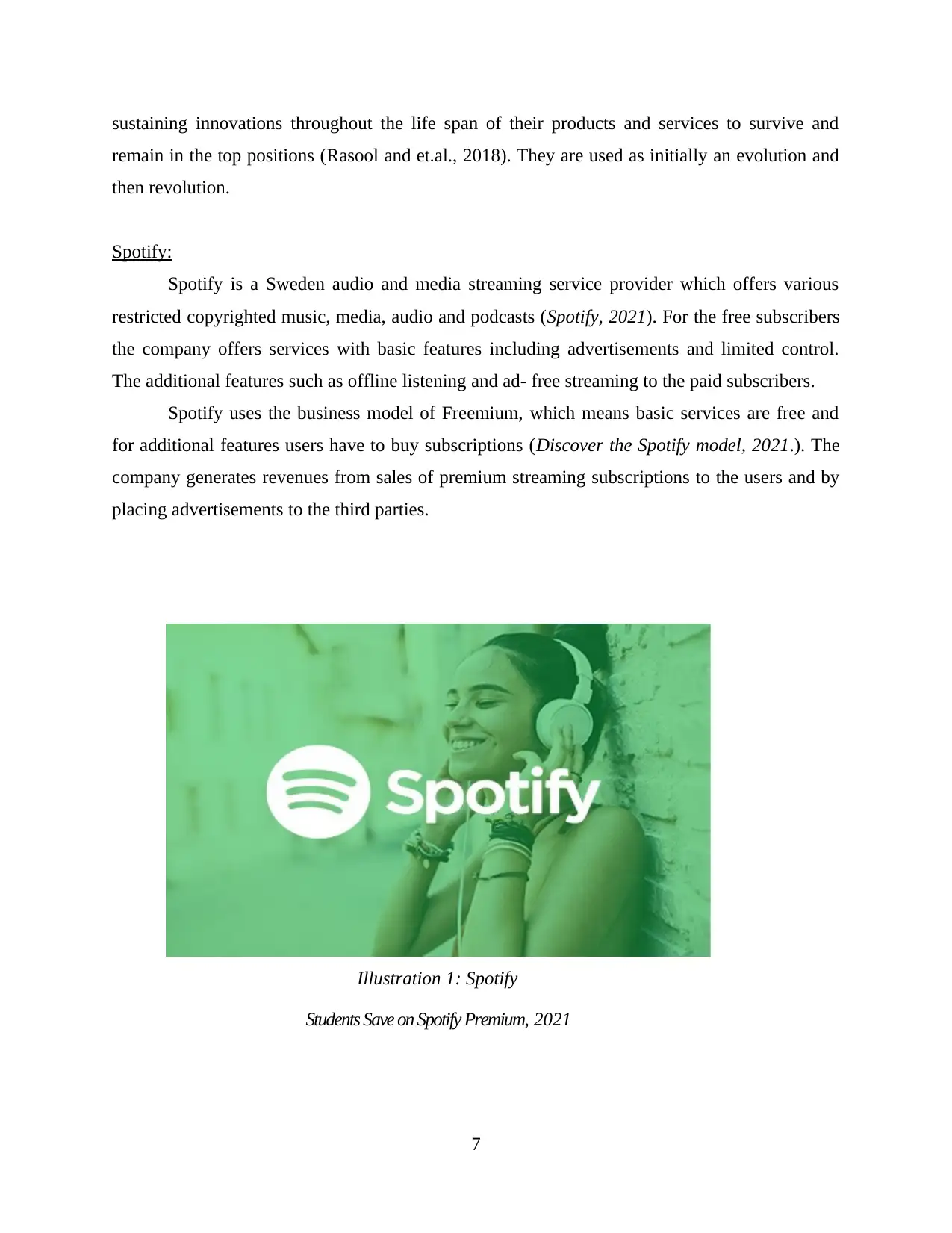
sustaining innovations throughout the life span of their products and services to survive and
remain in the top positions (Rasool and et.al., 2018). They are used as initially an evolution and
then revolution.
Spotify:
Spotify is a Sweden audio and media streaming service provider which offers various
restricted copyrighted music, media, audio and podcasts (Spotify, 2021). For the free subscribers
the company offers services with basic features including advertisements and limited control.
The additional features such as offline listening and ad- free streaming to the paid subscribers.
Spotify uses the business model of Freemium, which means basic services are free and
for additional features users have to buy subscriptions (Discover the Spotify model, 2021.). The
company generates revenues from sales of premium streaming subscriptions to the users and by
placing advertisements to the third parties.
7
Illustration 1: Spotify
Students Save on Spotify Premium, 2021
remain in the top positions (Rasool and et.al., 2018). They are used as initially an evolution and
then revolution.
Spotify:
Spotify is a Sweden audio and media streaming service provider which offers various
restricted copyrighted music, media, audio and podcasts (Spotify, 2021). For the free subscribers
the company offers services with basic features including advertisements and limited control.
The additional features such as offline listening and ad- free streaming to the paid subscribers.
Spotify uses the business model of Freemium, which means basic services are free and
for additional features users have to buy subscriptions (Discover the Spotify model, 2021.). The
company generates revenues from sales of premium streaming subscriptions to the users and by
placing advertisements to the third parties.
7
Illustration 1: Spotify
Students Save on Spotify Premium, 2021
Paraphrase This Document
Need a fresh take? Get an instant paraphrase of this document with our AI Paraphraser
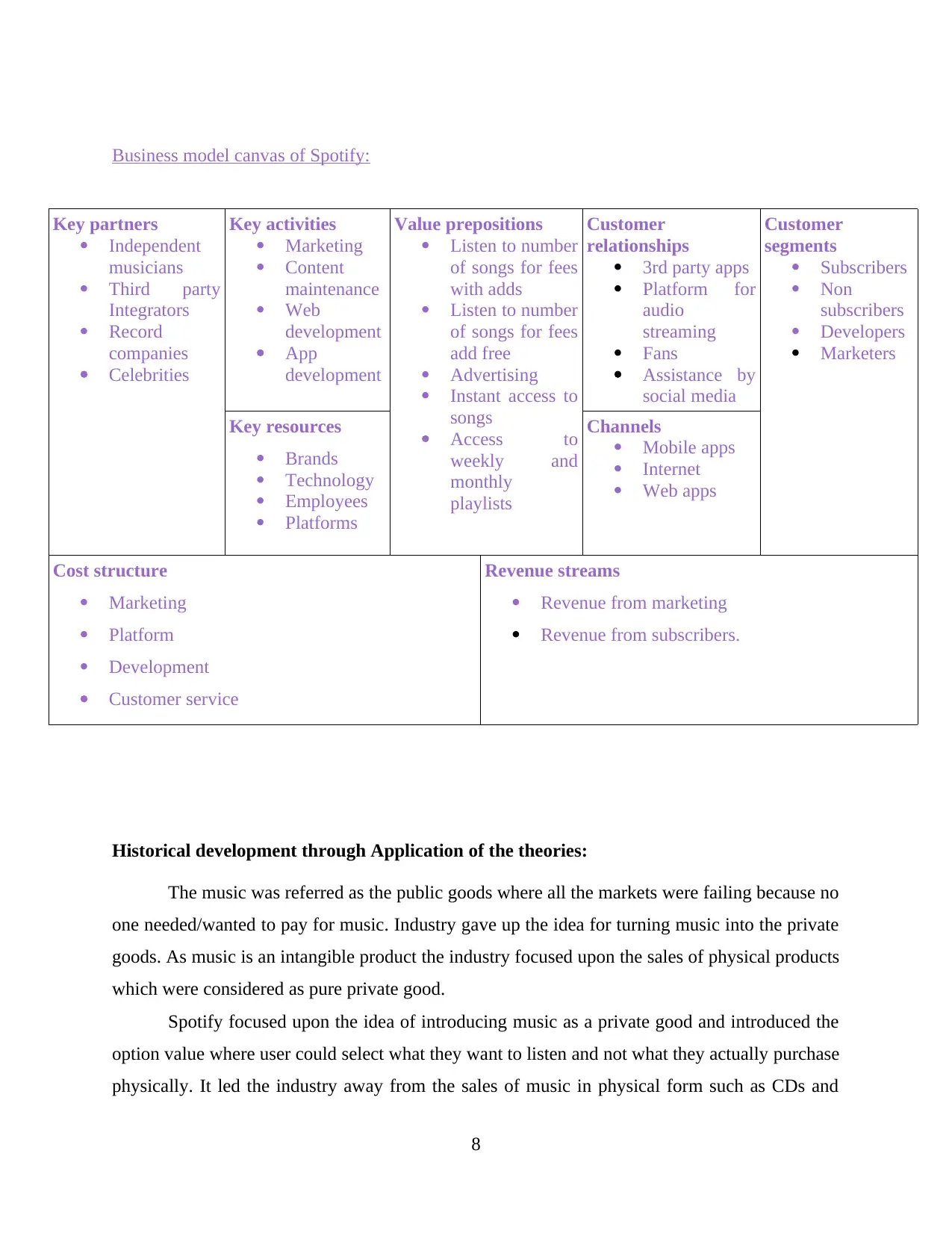
Business model canvas of Spotify:
Key partners
Independent
musicians
Third party
Integrators
Record
companies
Celebrities
Key activities
Marketing
Content
maintenance
Web
development
App
development
Value prepositions
Listen to number
of songs for fees
with adds
Listen to number
of songs for fees
add free
Advertising
Instant access to
songs
Access to
weekly and
monthly
playlists
Customer
relationships
3rd party apps
Platform for
audio
streaming
Fans
Assistance by
social media
Customer
segments
Subscribers
Non
subscribers
Developers
Marketers
Key resources
Brands
Technology
Employees
Platforms
Channels
Mobile apps
Internet
Web apps
Cost structure
Marketing
Platform
Development
Customer service
Revenue streams
Revenue from marketing
Revenue from subscribers.
Historical development through Application of the theories:
The music was referred as the public goods where all the markets were failing because no
one needed/wanted to pay for music. Industry gave up the idea for turning music into the private
goods. As music is an intangible product the industry focused upon the sales of physical products
which were considered as pure private good.
Spotify focused upon the idea of introducing music as a private good and introduced the
option value where user could select what they want to listen and not what they actually purchase
physically. It led the industry away from the sales of music in physical form such as CDs and
8
Key partners
Independent
musicians
Third party
Integrators
Record
companies
Celebrities
Key activities
Marketing
Content
maintenance
Web
development
App
development
Value prepositions
Listen to number
of songs for fees
with adds
Listen to number
of songs for fees
add free
Advertising
Instant access to
songs
Access to
weekly and
monthly
playlists
Customer
relationships
3rd party apps
Platform for
audio
streaming
Fans
Assistance by
social media
Customer
segments
Subscribers
Non
subscribers
Developers
Marketers
Key resources
Brands
Technology
Employees
Platforms
Channels
Mobile apps
Internet
Web apps
Cost structure
Marketing
Platform
Development
Customer service
Revenue streams
Revenue from marketing
Revenue from subscribers.
Historical development through Application of the theories:
The music was referred as the public goods where all the markets were failing because no
one needed/wanted to pay for music. Industry gave up the idea for turning music into the private
goods. As music is an intangible product the industry focused upon the sales of physical products
which were considered as pure private good.
Spotify focused upon the idea of introducing music as a private good and introduced the
option value where user could select what they want to listen and not what they actually purchase
physically. It led the industry away from the sales of music in physical form such as CDs and
8
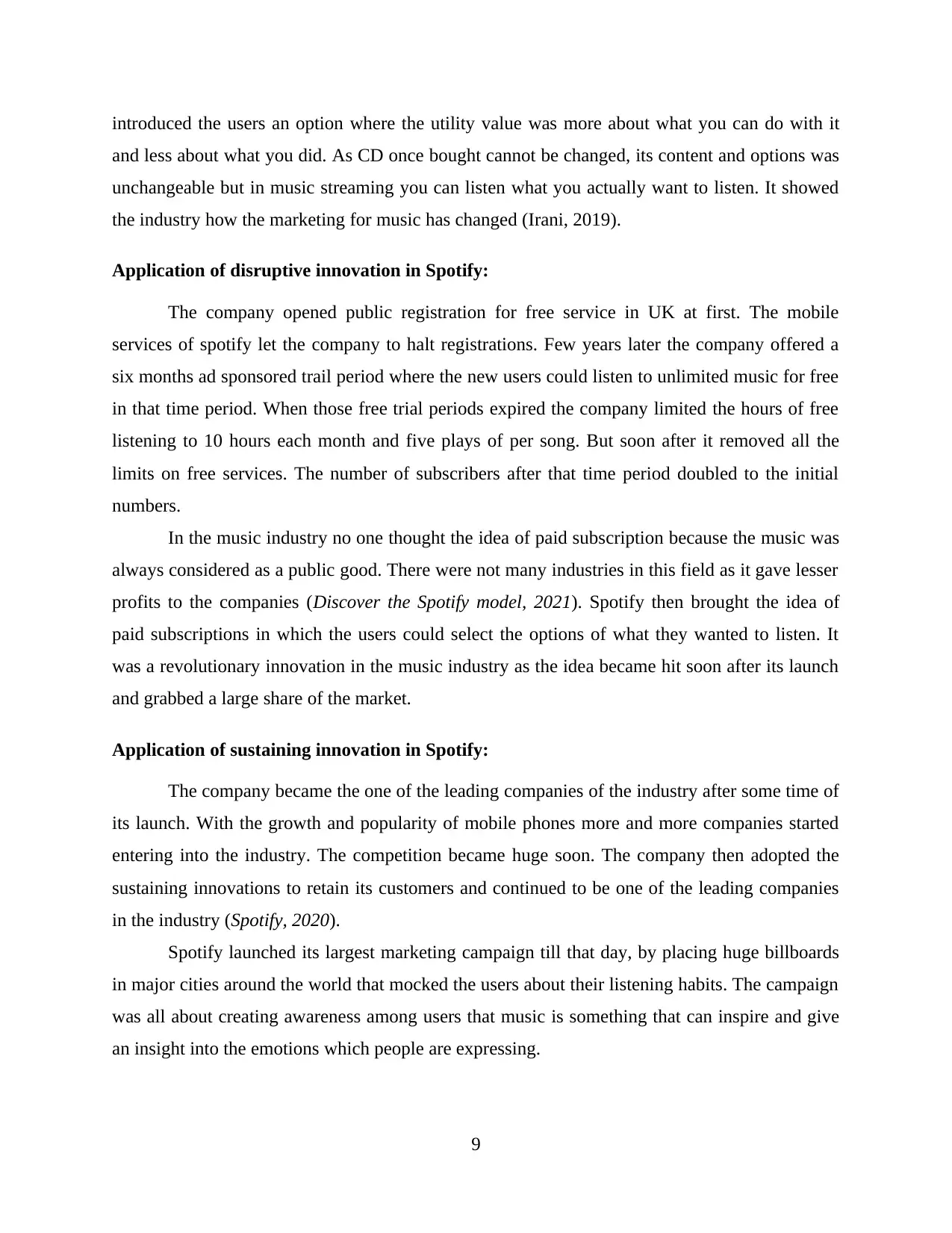
introduced the users an option where the utility value was more about what you can do with it
and less about what you did. As CD once bought cannot be changed, its content and options was
unchangeable but in music streaming you can listen what you actually want to listen. It showed
the industry how the marketing for music has changed (Irani, 2019).
Application of disruptive innovation in Spotify:
The company opened public registration for free service in UK at first. The mobile
services of spotify let the company to halt registrations. Few years later the company offered a
six months ad sponsored trail period where the new users could listen to unlimited music for free
in that time period. When those free trial periods expired the company limited the hours of free
listening to 10 hours each month and five plays of per song. But soon after it removed all the
limits on free services. The number of subscribers after that time period doubled to the initial
numbers.
In the music industry no one thought the idea of paid subscription because the music was
always considered as a public good. There were not many industries in this field as it gave lesser
profits to the companies (Discover the Spotify model, 2021). Spotify then brought the idea of
paid subscriptions in which the users could select the options of what they wanted to listen. It
was a revolutionary innovation in the music industry as the idea became hit soon after its launch
and grabbed a large share of the market.
Application of sustaining innovation in Spotify:
The company became the one of the leading companies of the industry after some time of
its launch. With the growth and popularity of mobile phones more and more companies started
entering into the industry. The competition became huge soon. The company then adopted the
sustaining innovations to retain its customers and continued to be one of the leading companies
in the industry (Spotify, 2020).
Spotify launched its largest marketing campaign till that day, by placing huge billboards
in major cities around the world that mocked the users about their listening habits. The campaign
was all about creating awareness among users that music is something that can inspire and give
an insight into the emotions which people are expressing.
9
and less about what you did. As CD once bought cannot be changed, its content and options was
unchangeable but in music streaming you can listen what you actually want to listen. It showed
the industry how the marketing for music has changed (Irani, 2019).
Application of disruptive innovation in Spotify:
The company opened public registration for free service in UK at first. The mobile
services of spotify let the company to halt registrations. Few years later the company offered a
six months ad sponsored trail period where the new users could listen to unlimited music for free
in that time period. When those free trial periods expired the company limited the hours of free
listening to 10 hours each month and five plays of per song. But soon after it removed all the
limits on free services. The number of subscribers after that time period doubled to the initial
numbers.
In the music industry no one thought the idea of paid subscription because the music was
always considered as a public good. There were not many industries in this field as it gave lesser
profits to the companies (Discover the Spotify model, 2021). Spotify then brought the idea of
paid subscriptions in which the users could select the options of what they wanted to listen. It
was a revolutionary innovation in the music industry as the idea became hit soon after its launch
and grabbed a large share of the market.
Application of sustaining innovation in Spotify:
The company became the one of the leading companies of the industry after some time of
its launch. With the growth and popularity of mobile phones more and more companies started
entering into the industry. The competition became huge soon. The company then adopted the
sustaining innovations to retain its customers and continued to be one of the leading companies
in the industry (Spotify, 2020).
Spotify launched its largest marketing campaign till that day, by placing huge billboards
in major cities around the world that mocked the users about their listening habits. The campaign
was all about creating awareness among users that music is something that can inspire and give
an insight into the emotions which people are expressing.
9
⊘ This is a preview!⊘
Do you want full access?
Subscribe today to unlock all pages.

Trusted by 1+ million students worldwide
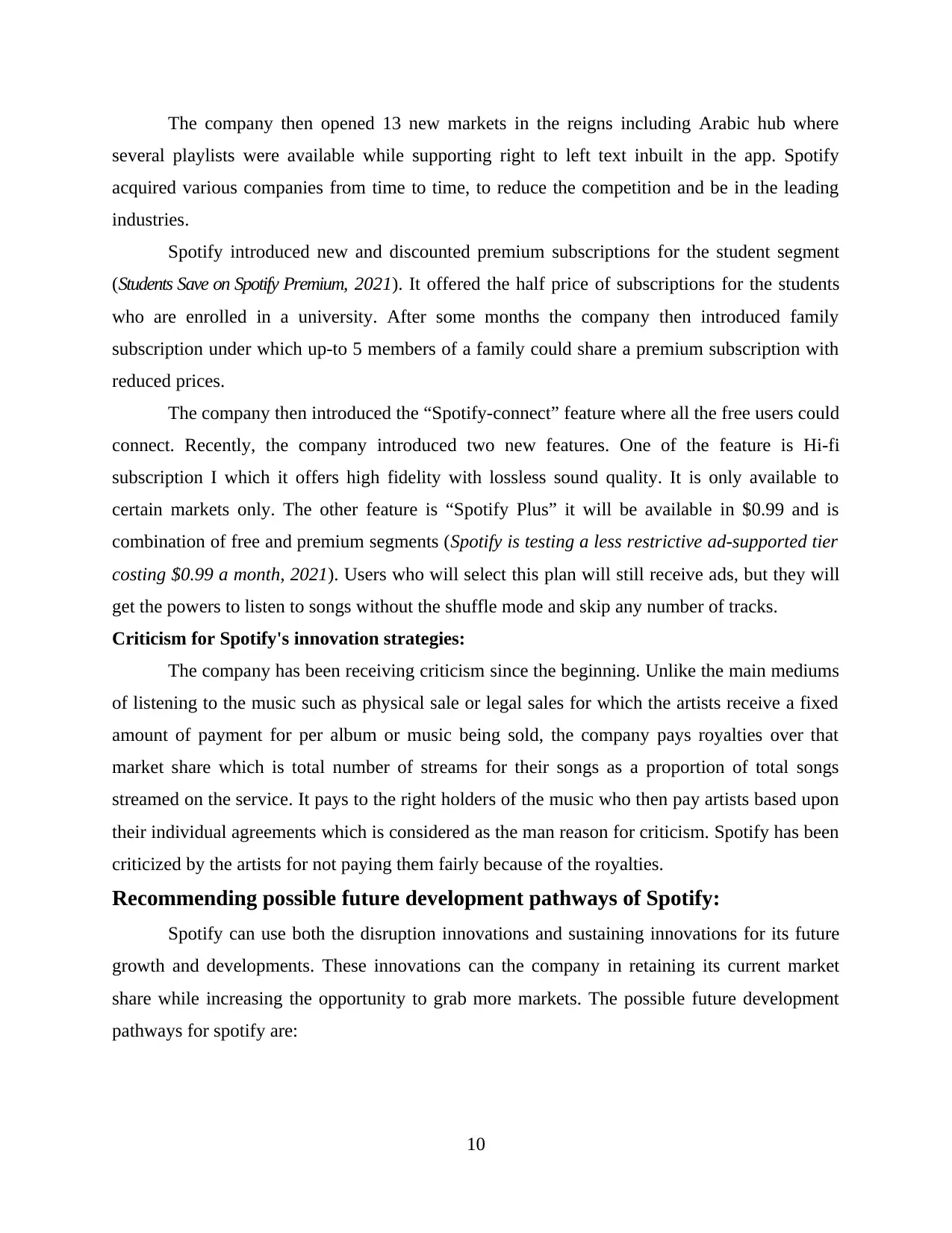
The company then opened 13 new markets in the reigns including Arabic hub where
several playlists were available while supporting right to left text inbuilt in the app. Spotify
acquired various companies from time to time, to reduce the competition and be in the leading
industries.
Spotify introduced new and discounted premium subscriptions for the student segment
(Students Save on Spotify Premium, 2021). It offered the half price of subscriptions for the students
who are enrolled in a university. After some months the company then introduced family
subscription under which up-to 5 members of a family could share a premium subscription with
reduced prices.
The company then introduced the “Spotify-connect” feature where all the free users could
connect. Recently, the company introduced two new features. One of the feature is Hi-fi
subscription I which it offers high fidelity with lossless sound quality. It is only available to
certain markets only. The other feature is “Spotify Plus” it will be available in $0.99 and is
combination of free and premium segments (Spotify is testing a less restrictive ad-supported tier
costing $0.99 a month, 2021). Users who will select this plan will still receive ads, but they will
get the powers to listen to songs without the shuffle mode and skip any number of tracks.
Criticism for Spotify's innovation strategies:
The company has been receiving criticism since the beginning. Unlike the main mediums
of listening to the music such as physical sale or legal sales for which the artists receive a fixed
amount of payment for per album or music being sold, the company pays royalties over that
market share which is total number of streams for their songs as a proportion of total songs
streamed on the service. It pays to the right holders of the music who then pay artists based upon
their individual agreements which is considered as the man reason for criticism. Spotify has been
criticized by the artists for not paying them fairly because of the royalties.
Recommending possible future development pathways of Spotify:
Spotify can use both the disruption innovations and sustaining innovations for its future
growth and developments. These innovations can the company in retaining its current market
share while increasing the opportunity to grab more markets. The possible future development
pathways for spotify are:
10
several playlists were available while supporting right to left text inbuilt in the app. Spotify
acquired various companies from time to time, to reduce the competition and be in the leading
industries.
Spotify introduced new and discounted premium subscriptions for the student segment
(Students Save on Spotify Premium, 2021). It offered the half price of subscriptions for the students
who are enrolled in a university. After some months the company then introduced family
subscription under which up-to 5 members of a family could share a premium subscription with
reduced prices.
The company then introduced the “Spotify-connect” feature where all the free users could
connect. Recently, the company introduced two new features. One of the feature is Hi-fi
subscription I which it offers high fidelity with lossless sound quality. It is only available to
certain markets only. The other feature is “Spotify Plus” it will be available in $0.99 and is
combination of free and premium segments (Spotify is testing a less restrictive ad-supported tier
costing $0.99 a month, 2021). Users who will select this plan will still receive ads, but they will
get the powers to listen to songs without the shuffle mode and skip any number of tracks.
Criticism for Spotify's innovation strategies:
The company has been receiving criticism since the beginning. Unlike the main mediums
of listening to the music such as physical sale or legal sales for which the artists receive a fixed
amount of payment for per album or music being sold, the company pays royalties over that
market share which is total number of streams for their songs as a proportion of total songs
streamed on the service. It pays to the right holders of the music who then pay artists based upon
their individual agreements which is considered as the man reason for criticism. Spotify has been
criticized by the artists for not paying them fairly because of the royalties.
Recommending possible future development pathways of Spotify:
Spotify can use both the disruption innovations and sustaining innovations for its future
growth and developments. These innovations can the company in retaining its current market
share while increasing the opportunity to grab more markets. The possible future development
pathways for spotify are:
10
Paraphrase This Document
Need a fresh take? Get an instant paraphrase of this document with our AI Paraphraser
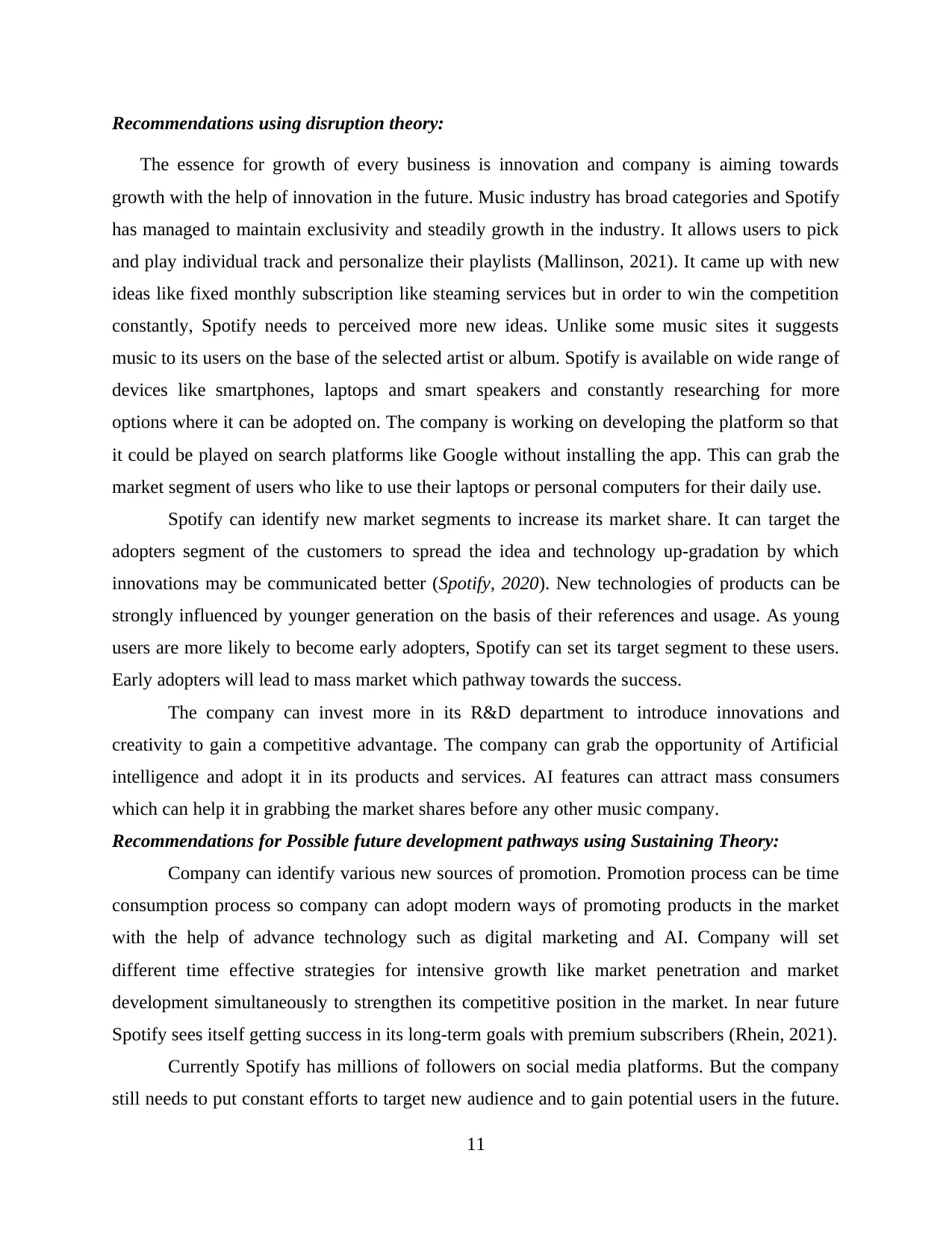
Recommendations using disruption theory:
The essence for growth of every business is innovation and company is aiming towards
growth with the help of innovation in the future. Music industry has broad categories and Spotify
has managed to maintain exclusivity and steadily growth in the industry. It allows users to pick
and play individual track and personalize their playlists (Mallinson, 2021). It came up with new
ideas like fixed monthly subscription like steaming services but in order to win the competition
constantly, Spotify needs to perceived more new ideas. Unlike some music sites it suggests
music to its users on the base of the selected artist or album. Spotify is available on wide range of
devices like smartphones, laptops and smart speakers and constantly researching for more
options where it can be adopted on. The company is working on developing the platform so that
it could be played on search platforms like Google without installing the app. This can grab the
market segment of users who like to use their laptops or personal computers for their daily use.
Spotify can identify new market segments to increase its market share. It can target the
adopters segment of the customers to spread the idea and technology up-gradation by which
innovations may be communicated better (Spotify, 2020). New technologies of products can be
strongly influenced by younger generation on the basis of their references and usage. As young
users are more likely to become early adopters, Spotify can set its target segment to these users.
Early adopters will lead to mass market which pathway towards the success.
The company can invest more in its R&D department to introduce innovations and
creativity to gain a competitive advantage. The company can grab the opportunity of Artificial
intelligence and adopt it in its products and services. AI features can attract mass consumers
which can help it in grabbing the market shares before any other music company.
Recommendations for Possible future development pathways using Sustaining Theory:
Company can identify various new sources of promotion. Promotion process can be time
consumption process so company can adopt modern ways of promoting products in the market
with the help of advance technology such as digital marketing and AI. Company will set
different time effective strategies for intensive growth like market penetration and market
development simultaneously to strengthen its competitive position in the market. In near future
Spotify sees itself getting success in its long-term goals with premium subscribers (Rhein, 2021).
Currently Spotify has millions of followers on social media platforms. But the company
still needs to put constant efforts to target new audience and to gain potential users in the future.
11
The essence for growth of every business is innovation and company is aiming towards
growth with the help of innovation in the future. Music industry has broad categories and Spotify
has managed to maintain exclusivity and steadily growth in the industry. It allows users to pick
and play individual track and personalize their playlists (Mallinson, 2021). It came up with new
ideas like fixed monthly subscription like steaming services but in order to win the competition
constantly, Spotify needs to perceived more new ideas. Unlike some music sites it suggests
music to its users on the base of the selected artist or album. Spotify is available on wide range of
devices like smartphones, laptops and smart speakers and constantly researching for more
options where it can be adopted on. The company is working on developing the platform so that
it could be played on search platforms like Google without installing the app. This can grab the
market segment of users who like to use their laptops or personal computers for their daily use.
Spotify can identify new market segments to increase its market share. It can target the
adopters segment of the customers to spread the idea and technology up-gradation by which
innovations may be communicated better (Spotify, 2020). New technologies of products can be
strongly influenced by younger generation on the basis of their references and usage. As young
users are more likely to become early adopters, Spotify can set its target segment to these users.
Early adopters will lead to mass market which pathway towards the success.
The company can invest more in its R&D department to introduce innovations and
creativity to gain a competitive advantage. The company can grab the opportunity of Artificial
intelligence and adopt it in its products and services. AI features can attract mass consumers
which can help it in grabbing the market shares before any other music company.
Recommendations for Possible future development pathways using Sustaining Theory:
Company can identify various new sources of promotion. Promotion process can be time
consumption process so company can adopt modern ways of promoting products in the market
with the help of advance technology such as digital marketing and AI. Company will set
different time effective strategies for intensive growth like market penetration and market
development simultaneously to strengthen its competitive position in the market. In near future
Spotify sees itself getting success in its long-term goals with premium subscribers (Rhein, 2021).
Currently Spotify has millions of followers on social media platforms. But the company
still needs to put constant efforts to target new audience and to gain potential users in the future.
11
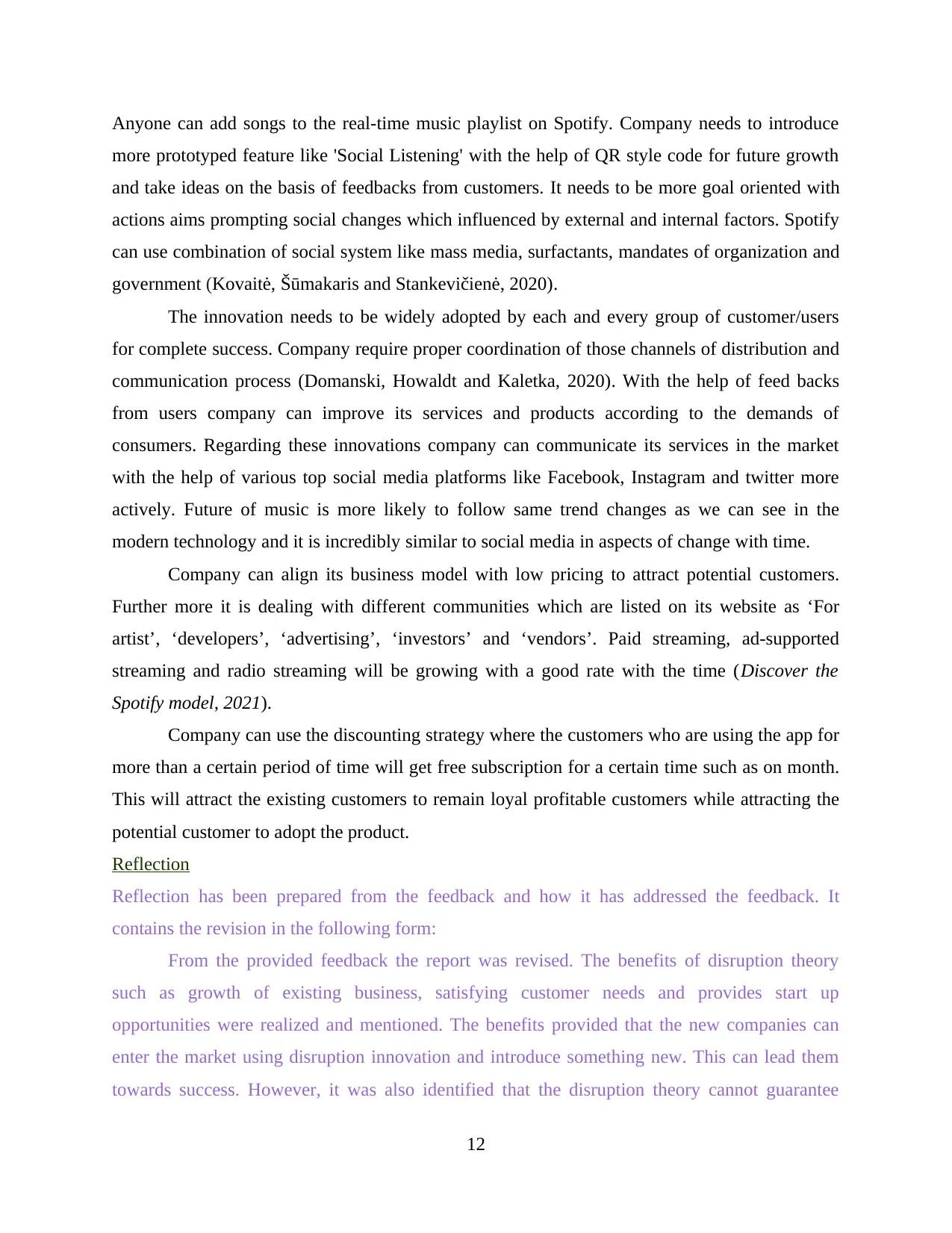
Anyone can add songs to the real-time music playlist on Spotify. Company needs to introduce
more prototyped feature like 'Social Listening' with the help of QR style code for future growth
and take ideas on the basis of feedbacks from customers. It needs to be more goal oriented with
actions aims prompting social changes which influenced by external and internal factors. Spotify
can use combination of social system like mass media, surfactants, mandates of organization and
government (Kovaitė, Šūmakaris and Stankevičienė, 2020).
The innovation needs to be widely adopted by each and every group of customer/users
for complete success. Company require proper coordination of those channels of distribution and
communication process (Domanski, Howaldt and Kaletka, 2020). With the help of feed backs
from users company can improve its services and products according to the demands of
consumers. Regarding these innovations company can communicate its services in the market
with the help of various top social media platforms like Facebook, Instagram and twitter more
actively. Future of music is more likely to follow same trend changes as we can see in the
modern technology and it is incredibly similar to social media in aspects of change with time.
Company can align its business model with low pricing to attract potential customers.
Further more it is dealing with different communities which are listed on its website as ‘For
artist’, ‘developers’, ‘advertising’, ‘investors’ and ‘vendors’. Paid streaming, ad-supported
streaming and radio streaming will be growing with a good rate with the time (Discover the
Spotify model, 2021).
Company can use the discounting strategy where the customers who are using the app for
more than a certain period of time will get free subscription for a certain time such as on month.
This will attract the existing customers to remain loyal profitable customers while attracting the
potential customer to adopt the product.
Reflection
Reflection has been prepared from the feedback and how it has addressed the feedback. It
contains the revision in the following form:
From the provided feedback the report was revised. The benefits of disruption theory
such as growth of existing business, satisfying customer needs and provides start up
opportunities were realized and mentioned. The benefits provided that the new companies can
enter the market using disruption innovation and introduce something new. This can lead them
towards success. However, it was also identified that the disruption theory cannot guarantee
12
more prototyped feature like 'Social Listening' with the help of QR style code for future growth
and take ideas on the basis of feedbacks from customers. It needs to be more goal oriented with
actions aims prompting social changes which influenced by external and internal factors. Spotify
can use combination of social system like mass media, surfactants, mandates of organization and
government (Kovaitė, Šūmakaris and Stankevičienė, 2020).
The innovation needs to be widely adopted by each and every group of customer/users
for complete success. Company require proper coordination of those channels of distribution and
communication process (Domanski, Howaldt and Kaletka, 2020). With the help of feed backs
from users company can improve its services and products according to the demands of
consumers. Regarding these innovations company can communicate its services in the market
with the help of various top social media platforms like Facebook, Instagram and twitter more
actively. Future of music is more likely to follow same trend changes as we can see in the
modern technology and it is incredibly similar to social media in aspects of change with time.
Company can align its business model with low pricing to attract potential customers.
Further more it is dealing with different communities which are listed on its website as ‘For
artist’, ‘developers’, ‘advertising’, ‘investors’ and ‘vendors’. Paid streaming, ad-supported
streaming and radio streaming will be growing with a good rate with the time (Discover the
Spotify model, 2021).
Company can use the discounting strategy where the customers who are using the app for
more than a certain period of time will get free subscription for a certain time such as on month.
This will attract the existing customers to remain loyal profitable customers while attracting the
potential customer to adopt the product.
Reflection
Reflection has been prepared from the feedback and how it has addressed the feedback. It
contains the revision in the following form:
From the provided feedback the report was revised. The benefits of disruption theory
such as growth of existing business, satisfying customer needs and provides start up
opportunities were realized and mentioned. The benefits provided that the new companies can
enter the market using disruption innovation and introduce something new. This can lead them
towards success. However, it was also identified that the disruption theory cannot guarantee
12
⊘ This is a preview!⊘
Do you want full access?
Subscribe today to unlock all pages.

Trusted by 1+ million students worldwide
1 out of 16
Related Documents
Your All-in-One AI-Powered Toolkit for Academic Success.
+13062052269
info@desklib.com
Available 24*7 on WhatsApp / Email
![[object Object]](/_next/static/media/star-bottom.7253800d.svg)
Unlock your academic potential
Copyright © 2020–2025 A2Z Services. All Rights Reserved. Developed and managed by ZUCOL.




